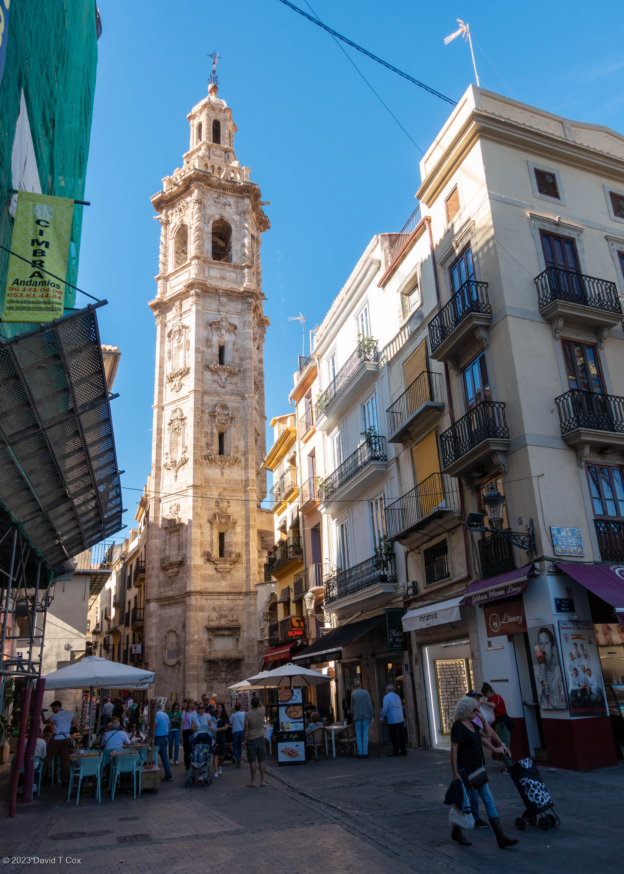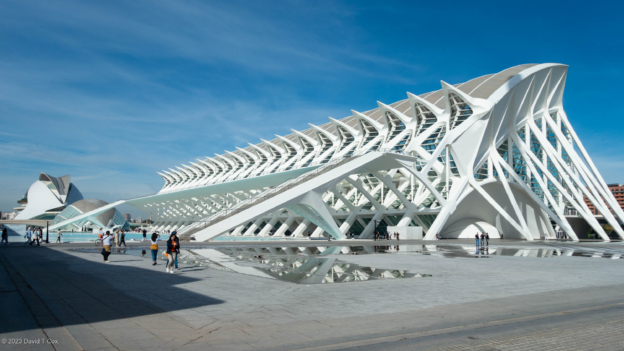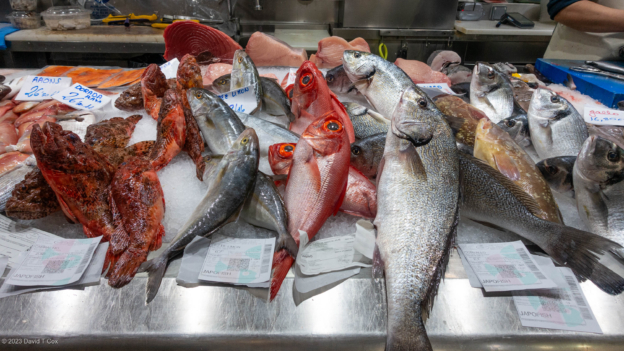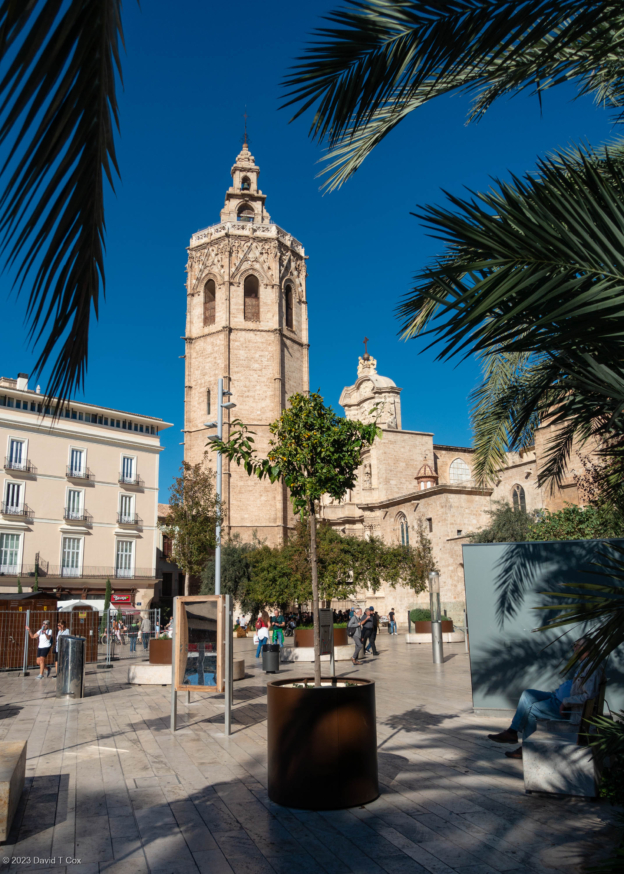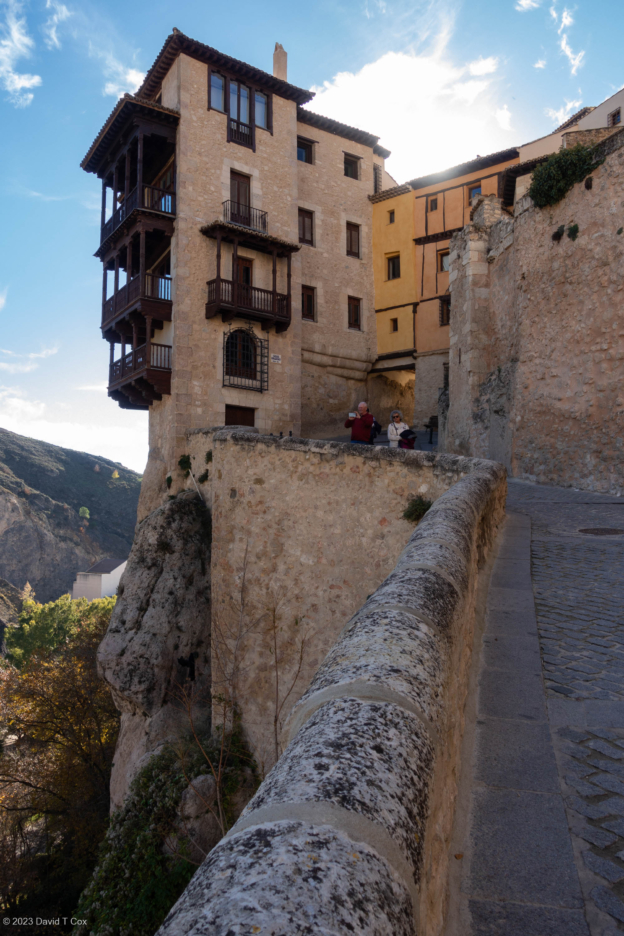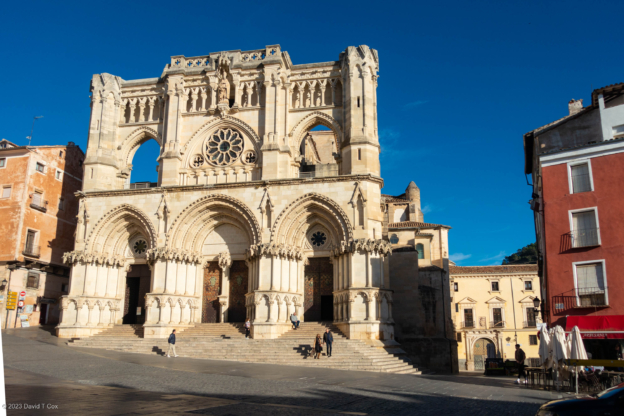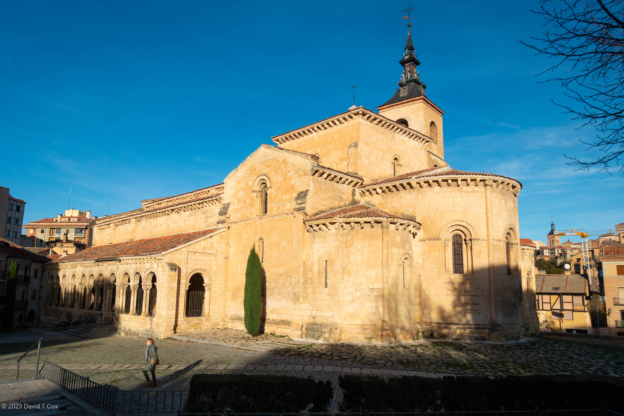All Photos Are Below the Travelogue Text
Click on Any Photo To Open Slide Show
To print the travelogue, right click anywhere on the page. Choose "Print" from your browser dialog box. You can choose Save to PDF in the browser print window.
Share your thoughts.
Email Dave - coxdavid55@hotmail.com
I traveled from Antequera to Valencia a couple of weeks ago. I have visited Valencia only once before, in 2006, and was limited to 2 days for lack of accommodations. I had arrived just a couple of days before the commencement of the America’s Cup world sailing race – the city was totally booked. This trip I took 6 leisurely days to enjoy the coastal city. I was in a lovely one-bedroom apartment just a couple of blocks from the cathedral and Plaza de Reina, pretty much in the center of all the tapas bars and restaurants.
I spent one day at the Oceanografic Aquarium, the largest in Europe. It had a number of giant underwater walkways with sea-life from all the oceans of the world. It also had large numbers of schoolkids on group learning tours. The Oceanografic is the southernmost of 6 remarkable structures making up the Science and Arts city along the green zone. The architecture of these giant structures is designed to mimic giant crustaceans.
The Valencia Market is the largest of its kind, and wandering the stalls is a study in colors and crowd shopping. One huge section is all fresh and often living seafood, a veritable magnet for photography. Next to the market is the most interesting structure of the city and a World Heritage Site – the Lonja de Seda, or Silk Exchange. The building was constructed in the 15th century in late gothic style for commercial trading in various goods including silk. The giant interior hall rises to heights on slender fluted pillars. The entrances and roofing edges are carved with gargoyles.
From Valencia I took the train to Cuenca, the old town of which rises rapidly from the juncture of a river and small stream until it sits between two vertical sets of cliff faces. The road upward cuts a few hairpins until one reaches the elongated plaza mayor and cathedral, then continues to rise to the mirador (overlook). Three-and-four story old homes constructed right on the edge of the cliffs make for incredible sights as the sun finally rises high enough over the canyons to light the fall-colored trees. Overhead in the blue skies are groups of Griffon Vultures, impressive with 8 to 9 foot wingspans and colored gold and black. I had a tiny apartment just 100 meters below the Plaza Mayor where I spent time at the Meson San Juan Plaza Mayor, as it opened before dawn daily at 7am and did not close until midnight – serving lattes around a roaring fire in the dawn, serving great “menu del dias” at lunch and finally beer and wine with tapas in the evening. I hiked the steep roads down the mountain daily, and then (groan) back up to the mirador.
From Cuenca I traveled finally to Segovia, where I have visited twice before. The town, just north of Madrid, has perhaps the most impressive aqueduct in existence, built by the Romans in the 1st century ad. With double arches stabilizing the pillars, at over 100 feet in height, the massive stones use no mortar and have stood for 2,000 years. Equally impressive is the medieval Alcazar, first built in the 12th century and restored on several occasions with the last architectural phase in the 16th century. It often served to seasonally house many of the Spanish royalty over 700 years, and was where Queen Isabela became queen. A World Heritage site, its “witch’s hat” turrets almost certainly helped inspire the Disney castle. Finally, Segovia is simply full of medieval 12th century Romanesque churches with their classic narrow double columnated semi-circular windows and barrel vaults. All of the aforementioned surround the highest point where stands the golden late Gothic cathedral. Several times in Segovia I was fortunate to see the Cinereous Vultures overhead, equaling the size of Andean Condors as the largest raptors in the world.
I have sampled specialty foods from most of my stays in Spain. In Vigo it was the fresh seafood, but particularly the broiled scallops on the half shell drizzled with olive oil and lime juice. Salamanca, as always, famous for its Jamon Iberico bellota (ham from an ancient breed of black pigs, acorn fed). Cordoba offered its berenjenas califales con miel (crispy fried thin sliced eggplant drizzled with honey). Valencia, home of paella, offered saffron infused rice, slow cooked with rabbit and other meats in shallow black skillets to get a crispy slightly burned texture to the bottom layer; the authentic dish is prepared to personal order and takes from 35 minutes to an hour and is served in the skillet. Segovia is famous for its cochinillo, roasted suckling pig with crispy skin; I had mine as a quartered leg, hoof and all; dining alone provided the advantage of not having enough people to be served the entire pig, head and all. Amazingly, I do not believe I have gained any weight, probably due to walking many miles a day.
Mentioning the great foods requires some balance to the obverse – Segovia’s tapas almost always include various pig parts; I have carefully avoided sliced up strips of pig ears, but in dim light I mistakenly ordered sliced pig snouts the other night. In my travels over the years I have eaten fried rattlesnake, scrambled cow brains, beef tongue and tripe, estuarine crocodile stew, boot-of-Italy horse meat, Oaxacan fried grasshoppers and Peruvian roasted guinea pig BUT – I drew the line at pig ears and snout.
From Segovia I returned the 100 kilometers to Madrid, where I am spending 3 days before the flight back to Tucson. Later. Dave
- Santa Catalina bell tower rebuilt 17th C baroque, Valencia, Spain
- Museum of Science, Valencia, Spain
- Valencia Market, Spain
- Valencia Market, Spain
- Lonja de la Seda main hall, pano, 15th C late gothic, World Heritage Site, Valencia, Spain
- Catedral, Valencia, Spain
- view from behind cathedral and Puent San Pablo, Cuenca, Spain
- Cuenca Cathedral on Plaza Mayor, Spain
- Hanging House from Puente San Pablo, Cuenca, Spain
- Iglesia de San MIllan, 12th C Romanesque, Segovia, Spain
- Cathedral, Segovia, Spain
- Alcazar, Segovia, Spain
- Iglesia Vera Cruz 13th C Romanesque, Knights Templar, Segovia, Spain
- Acueducto de Segovia pano2, Roman, Spain
To print the travelogue, right click anywhere on the page. Choose "Print" from your browser dialog box. You can choose Save to PDF in the browser print window.
Share your thoughts.
Email Dave - coxdavid55@hotmail.com

